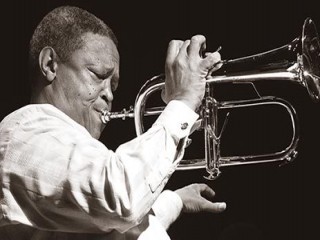
Hugh Masekela biography
Date of birth : 1939-04-04
Date of death : -
Birthplace : Witbank, South Africa
Nationality : South African
Category : Arts and Entertainment
Last modified : 2011-07-01
Credited as : Jazz Afrobeat, trumpeter, composer and singer
2 votes so far
Hugh Masekela has an extensive jazz background and credentials, but has enjoyed major success as one of the earliest leaders in the world fusion mode. Masekela's vibrant trumpet and flügelhorn solos have been featured in pop, R&B, disco, Afro-pop, and jazz contexts. He's had American and international hits, worked with bands around the world, and played with African, African-American, European, and various American musicians during a stellar career. His style, especially on flügelhorn, is a charismatic blend of striking upper-register lines, half-valve effects, and repetitive figures and phrases, with some note bending, slurs, and tonal colors. Though he's often simplified his playing to fit into restrictive pop formulas, Masekela is capable of outstanding ballad and bebop work.
He began singing and playing piano as a child, influenced by seeing the film Young Man with a Horn at 13. Masekela started playing trumpet at 14. He played in the Huddleston Jazz Band, which was led by anti-apartheid crusader and group head Trevor Huddleston. Huddleston was eventually deported, and Masekela co-founded the Merry Makers of Springs along with Jonas Gwangwa. He later joined Alfred Herbert's Jazz Revue, and played in studio bands backing popular singers. Masekela was in the orchestra for the musical King Kong, whose cast included Miriam Makeba. He was also in the Jazz Epistles with Abdullah Ibrahim, Makaya Ntshoko, Gwanga, and Kippie Moeketsi. Masekela and Makeba, his wife at that time, left South Africa one year before Ibrahim and Sathima Bea Benjamin in 1961. Such musicians as Dizzy Gillespie, John Dankworth, and Harry Belafonte assisted him. Masekela studied at the Royal Academy of Music, then the Manhattan School of Music. During the early '60s, his career began to explode. He recorded for MGM, Mercury, and Verve, developing his hybrid African/pop/jazz style. Masekela moved to California and started his own record label, Chisa. He cut several albums expanding this formula and began to score pop success. The song "Grazing in the Grass" topped the charts in 1968 and eventually sold four million copies worldwide. That year Masekela sold out arenas nationwide during his tour, among them Carnegie Hall. He recorded in the early '70s with Monk Montgomery & the Crusaders.
Masekela moved in a more ethnic direction during the '70s. He traveled to London to play with Nigerian Afro-beat great Fela Kuti & Africa 70; then came a session with Dudu Pukwana, Eddie Gomez, and Ntshoko, among others, that resulted in his finest jazz/African album, Home Is Where the Music Is. Masekela toured Guinea with the Ghanian Afro-pop band Hedzoleh Soundz, then recorded a series of albums with them both in California and Africa with guest stints from the Crusaders, Patti Austin, and others. Masekela alternated between America and Africa, cutting a successful pop/dance album with Herb Alpert in the late '70s. During the '80s, Masekela returned to South Africa. He visited Zimbabwe and Botswana, and recorded two albums with the Kalahari Band that once more merged jazz-rock, funk, and pop. Masekela was part of Paul Simon's Graceland tour in the mid-'80s, while he continued recording and produced sessions by Makeba. Starting in the mid-'90s, Masekela began releasing a stream of albums and collections that showed his versatility and growth in South African jazz. Though the jazz content of his work has varied over the years, Hugh Masekela has far more material on the plus side than the negative.


















